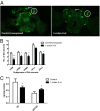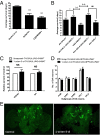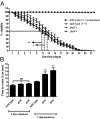Fungal-derived semiochemical 1-octen-3-ol disrupts dopamine packaging and causes neurodegeneration
- PMID: 24218591
- PMCID: PMC3845153
- DOI: 10.1073/pnas.1318830110
Fungal-derived semiochemical 1-octen-3-ol disrupts dopamine packaging and causes neurodegeneration
Abstract
Parkinson disease (PD) is the most common movement disorder and, although the exact causes are unknown, recent epidemiological and experimental studies indicate that several environmental agents may be significant risk factors. To date, these suspected environmental risk factors have been man-made chemicals. In this report, we demonstrate via genetic, biochemical, and immunological studies that the common volatile fungal semiochemical 1-octen-3-ol reduces dopamine levels and causes dopamine neuron degeneration in Drosophila melanogaster. Overexpression of the vesicular monoamine transporter (VMAT) rescued the dopamine toxicity and neurodegeneration, whereas mutations decreasing VMAT and tyrosine hydroxylase exacerbated toxicity. Furthermore, 1-octen-3-ol also inhibited uptake of dopamine in human cell lines expressing the human plasma membrane dopamine transporter (DAT) and human VMAT ortholog, VMAT2. These data demonstrate that 1-octen-3-ol exerts toxicity via disruption of dopamine homeostasis and may represent a naturally occurring environmental agent involved in parkinsonism.
Keywords: building-related illness; mold; mushroom alcohol.
Conflict of interest statement
The authors declare no conflict of interest.
Figures





References
-
- Jellinger KA. The pathology of Parkinson’s disease. Adv Neurol. 2001;86:55–72. - PubMed
-
- Schapira AH, Jenner P. Etiology and pathogenesis of Parkinson’s disease. Mov Disord. 2011;26(6):1049–1055. - PubMed
-
- Kumar KR, Lohmann K, Klein C. Genetics of Parkinson disease and other movement disorders. Curr Opin Neurol. 2012;25(4):466–474. - PubMed
Publication types
MeSH terms
Substances
Grants and funding
- P30ES019776/ES/NIEHS NIH HHS/United States
- R01ES015991/ES/NIEHS NIH HHS/United States
- P30 ES019776/ES/NIEHS NIH HHS/United States
- R21NS072097/NS/NINDS NIH HHS/United States
- U01 NS079249/NS/NINDS NIH HHS/United States
- T32 ES012870/ES/NIEHS NIH HHS/United States
- R21 NS072097/NS/NINDS NIH HHS/United States
- P50NS071669/NS/NINDS NIH HHS/United States
- P30 ES005022/ES/NIEHS NIH HHS/United States
- R01 ES015991/ES/NIEHS NIH HHS/United States
- P50 NS071669/NS/NINDS NIH HHS/United States
- P30ES005022/ES/NIEHS NIH HHS/United States
LinkOut - more resources
Full Text Sources
Other Literature Sources
Molecular Biology Databases

